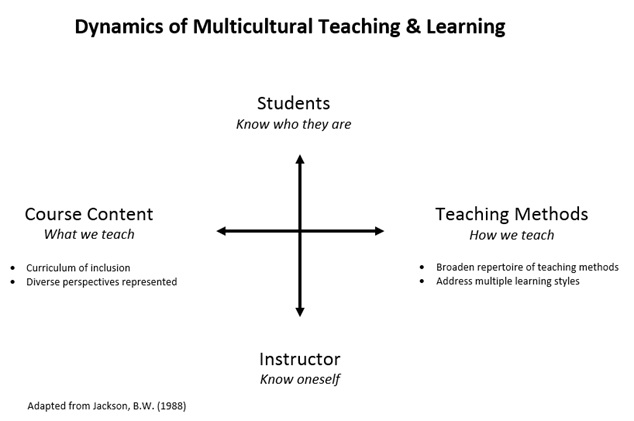Multicultural Course Design
Wayne State University (WSU) prides itself on the diversity of our students. Earlier thinking framed diversity as primarily racial and ethnic diversity, however in today's society, diversity is much broader than those differences alone. Multiculturally inclusive teaching is a commitment to address the variety of ways students may feel included or excluded in the college classroom. It also includes instructor self-reflection, pedagogical innovation, and understanding your students and what they bring to the course. Addressing the learning needs of diverse students helps to ensure all WSU students can reach their maximum potential.
Four dimensions of teaching and learning that are especially relevant to multicultural course design are:
- Students understand the ways students' backgrounds influence their experience in your course.
- Instructor recognize how your experiences, beliefs, and comfort levels affect your interactions with students.
- Course Content Create a curriculum that incorporates diverse perspectives.
- Teaching Methods Vary your pedagogical methods to address multiple learning styles.

Additional resources for multicultural course design
We recommend reviewing Tips for Creating an Inclusive Classroom within "The Chicago Handbook for Teachers." This chapter includes best practices for creating and sustaining an inclusive classroom.
University of Colorado Boulder put together a series of short essays on diversity. Some titles include "Developing and Teaching an Inclusive Curriculum," "Fostering Diversity in the Classroom: Teaching by Discussion," and "The Influence of Attitudes, Feelings and Behavior Toward Diversity on Teaching and Learning." You can find the essays at Diversity in the Classroom (Essay Series, University of Colorado, Boulder).
In 2010, Eve Fine and Jo Handelsman published Benefits and Challenges of Diversity in Academic Settings for Women in Science & Engineering Leadership Institute (WISELI). This document overviews the benefits for both instructors and students and how to minimize the challenges.
Recognizing and Addressing Cultural Variations in the Classroom, from Carnegie Mellon, is a guide for teaching in a multi-cultural setting.